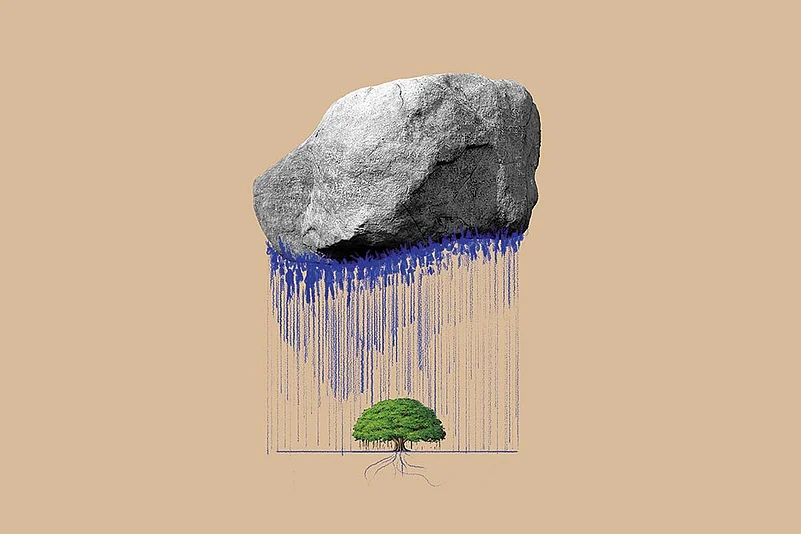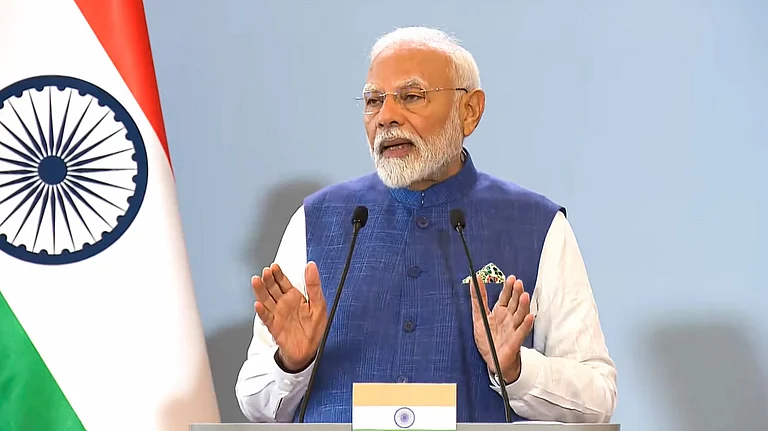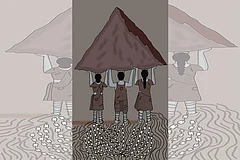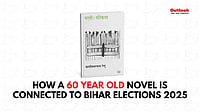Colours carry meaning. Meanings that are shared by an entire culture, an entire people. Even a change in shade can change the meaning. The significance of colours plays out in myriad ways, picking up bits and pieces from the past, imbuing them with new meanings, often seeking to transform the lived reality of a people. So, when in 1921, Sikh leaders insisted that black was the colour that represented the Sikhs of India and that their identity was distinct from all other communities in India, Mahatma Gandhi was, to say the least, flabbergasted.
Gandhi, already a mass leader and known reverentially as the ‘Mahatma’ at the age of 50, sought to dip into shared meanings to explain to the people of India the design of a national flag for India, which he thought was most appropriate for the nation. The country was at that time in the middle of the Non-Cooperation Movement. On August 2, 1920, Gandhi had promised Indians that with their support, he would bring Swaraj within a year. People stepped out on the streets in large numbers such as India had never seen before. Now was the time to bring out a national flag for the nation. After all, since the French Revolution of 1789, which had overthrown one of the most powerful absolutist rulers of the world, every respectable nation was supposed to have a national flag. The colours of the flag were designed to assert the ideological underpinnings of the nation. Gandhi’s design, the first iteration of which he made public in his journal Young India dated April 14, 1921, was a red and green flag designed at his behest by Pingali Venkayya, a young college student from Masulipatnam. At the centre of this flag was to be a charkha, suggested by the revolutionary leader from Punjab, Lala Hansraj. Red was, according to Gandhi, the colour of Hindus; green that of Muslims.
But if Hindus and Muslims were to find a place on the flag then there was a problem. Gandhi being well-versed in the mores of the country and sensitive to signs and symbols, was fully aware that neither Hindus nor Muslims were clearly defined in India. Moreover, there were hundreds of other dharma paramparas, which were followed by those who identified themselves as Hindus and Muslims. Gandhi’s mother, Putlibai, was a follower of Pran Nath, a sant, in whose teachings intersected Jain, Vaishnav and Christian ideas. To accommodate them, in the second iteration of the national flag, Gandhi included the colour white.
On a white, green, and red flag, Gandhi’s reasoning went something like this: the weakest and the least numerous were to be represented by white at the top; followed by ‘the Islamic colour’ and last came ‘the Hindu colour red’. A charkha at the centre, of course, represented concern for the poorest of the poor.
Sikhs were told that they would just have to accept whatever was on offer. You are “needlessly agitated”, Gandhi wrote. “To ask for special prominence is tantamount to a refusal to merge in the two numerically great communities,” Gandhi chided the Sikhs. He also conceded that the “quarrel between Hindus and Mussulmans” was intractable, that Sikhs had never had any difference with Hindus and that the Sikhs’ “quarrel with the Mussulmans was of the same type as the Hindus”.
Here we need to remember that among the politically forward-looking public figures of that time, religion and religious colours were the focus of nationhood as far as India was concerned. Since the liberal government had taken over in Britain in 1907, sovereignty for a people in India was being defined as sovereignty for a religious group.
Gandhi’s pointsman among Muslims, Maulana Mohamed Ali, had even drawn up a detailed plan of India’s future as a ‘‘United States of Religion’’. These plans, published earlier in his newspaper The Comrade, also underlay his adoption of the title ‘‘Maulana’’ as soon as he managed to read the Quran during his house arrest. His older brother Shaukat, who hadn’t yet read the Quran fully, also started calling himself ‘‘Maulana’’. And that is how the two came to be known in the Indian national movement: Maulanas Mohamed Ali and Shaukat Ali.
The bits of correspondence, preserved at the Gandhi Memorial Library at Rajghat, tell us that the Sikhs refused to be clubbed with the whites. The Sikhs informed Gandhi that the national flag of India needed to have a black stripe too since black was the colour of the Sikhs.
By 1929, with the success of the Akali movement, the demand for a separate Sikh colour became even more assertive. After all, it was well known that the Akali movement had succeeded in wresting control of gurdwaras in Punjab from Brahmin mahants because the British Indian Army was completely dependent upon Sikh soldiers, particularly the Jats.
Consequent upon the success of the Akali movement, the Akali Dal had emerged as a movement for cultural and social reform of the Sikhs. Led by Baba Kharak Singh, it was working to protect Sikh interests in Punjab vis-à-vis Muslims. This would often result in communal clashes—mostly over property. And Gandhi’s version of the national flag denoting Hindu-Muslim unity with everyone else being thrown into a single cauldron could not be allowed to go unchallenged.
Kesari was also the colour of ‘‘do or die’’ bravery. Hence, kesari bana, which would be worn by brave Rajput warriors.
Major A E Barstow’s famous Handbooks for the Indian Army: Sikhs published for the instruction of officers who commanded the Sikh regiment was revised in 1928, to include the matter of colour sensitivities. “At the request of the Government of India,” it said, distancing the author just a little bit from the original text. The handbook talked of Sikhs as fighting the “political tyranny of the Musalman and the social tyranny of the Hindus”. It warned about colours. No bhagwa (saffron) colour for the Sikhs since that was the colour of the Hindus. Bhagwa, the handbook explained, was the colour of renunciation. The Sikhs did not renounce the world. Rather, they strived to protect dharma by taking up arms.
The revised version pointed out that Sikhism had been on the wane in the 19th century. But it started growing again. The number of Sikhs, it said, went up from 17,06,165 in 1881 to 31,10,000 in 1921. It also warned that the Sikhs had been prohibited by their religion from eating halal meat, from bowing to a Brahmin and from drinking the charanamrut (foot-wash) of anyone, god or king; instead they drank only amrut, amrut chakhna, literally “divine nectar”.
It was only when the British thus formally began to sow the seeds of separation between the Sikhs and the Hindus that Gandhi abandoned his quest for national sovereignty based on religion. He also changed the meanings that he was attributing to the national colours of India. Now, in 1929, he said that red stood for sacrifice, white for purity, and green for hope.
By now, newspaper headline of Communist conspiracies and attacks in India headlines had started coming in. A bomb explosion in the Council Chamber on April 8, 1929, was widely reported to be the doing of the Communists. In the light of such action, the colour red was quietly dropped from the national flag. This is how India’s national flag came to have a kesari stripe in its top one third.
The colour kesari, a variant of the colour of haldi, haridhra, was in another variant; also the colour of kumkum, the colour of positivity, of being blessed. Indian sanyasis and sadhus traditionally wore a kesari garb referred to as kashayam, for being coloured in the water extract of haldi. In yet another variant, Narayana Guru of Kerala, working for the upliftment of the Ezhavas—the most untouchable within a society that insisted on classifying humans on the basis of who was more untouchable—made it the colour of the order of sanyasins that he established.
Kesari was also the colour of ‘‘do or die’’ bravery. Hence, kesari bana, which would be worn by brave Rajput warriors as they went forth to ritualistically battle those who had come to desecrate their land. For those who are merely brave and not interested in either dying or renouncing the world, it is an even lighter shade of haridhra that was used. This is the colour basanti--the colour of the yellow mustard flower. It’s a colour of joy, heroism, success.
It was sensitivity to this context that made Prem Dhawan use the colour basanti in his famous song ‘Mera Rang De Basanti Chola’. As he explains in a line, ‘‘Jis Chole ko Pehan Shivaji Khele Apni Jaan Pe; Jise Pehan Jhansi ki Rani Mit Gayi Apni Aan pe’’ (The cloak that Shivaji wore when he fought with his life on the line; The cloak that the queen of Jhansi wore and fought for her pride). No one in India needed to be told what basanti stood for here. Manoj Kumar is on record saying that Prem Dhawan penned these lines after the entire team of the film Shaheed went on a long road trip to Shaheed Bhagat Singh’s ancestral village to meet his mother and get a feel of the subject that they were filming. All along the way they saw yellow mustard fields. By the time the journey was over, Dhawan had penned one of the most iconic lyrics of India.
The colour basanti also featured in the national flag of Mongolia, which was crafted in 1911. Here too it carried the same meanings as it did in India. The other colour featured on the flag was blue, representing the open skies under which the culture of the people had evolved. In addition, the flag carried an icon called the soyombo, a word derived from the same root as svayambhu, indicating the power of self-regeneration. When the Communists came to power in Mongolia, they changed the colour basanti to red and the soyombo was replaced by a star. After the cessation of Communist rule, the colour red was retained since it did carry the same meaning as basanti. But the star was removed and the soyombo brought back to adorn the flag. Today, the Mongolian national flag has icons and colour symbolism which are much like what those icons and colours mean in India.
(Views expressed are personal)
MORE FROM THIS ISSUE
M Rajivlochan is a professor at Panjab University
(This appeared in the print as 'What’s In A Colour?')




























